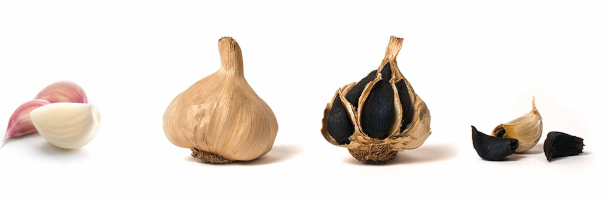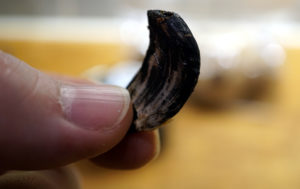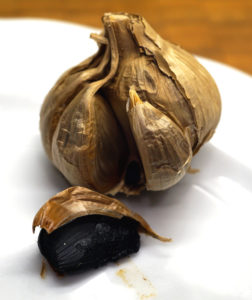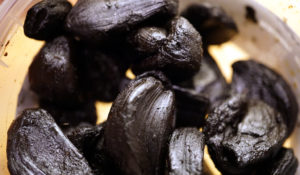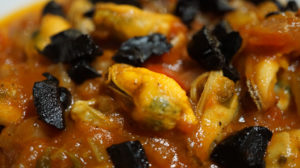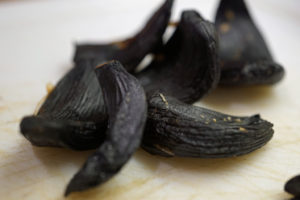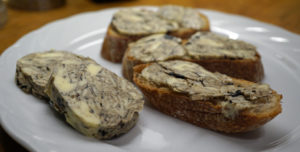Preamble
In the following we will talk about the black garlic. I hope that for all those who suffer from Alliumphobie (fear of garlic & onions) we at least be able to take the fear of garlic, because the black garlic is the clearly more compatible one!
I have contacted about ten different European producers of black garlic in advance to give you a good overview of the current range. Six candidates have kindly agreed to support me with their products, but above all with their expertise.
I am particularly pleased that, in addition to Spanish companies, there are also companies from Italy, England and Germany who have supported me regarding the article.
So many thanks to the manufacturers & suppliers who made this contribution possible!
The Origin
It is said that black garlic was first discovered in Japan as a result of the fermentation and maturation of ordinary garlic.
There is real evidence that thousands of years earlier garlic had been used as a burial ingredient in Egypt. Even then, not only the culinary benefits but also the health-promoting potential of garlic were said to have been known. The extent to which black garlic may already have existed there cannot be proven beyond doubt.
The vast majority of the sources I have researched indicate that the first black garlic comes from Korea – it will probably not be possible to clarify this exactly. However, it is clear that Asia has been ahead of the pack in terms of black garlic for many decades.
What is Black Garlic?
Black garlic is not a specific variety whose cloves are black by nature. Nor is it the classic smoked garlic – the colouring of the cloves is due to a fermentation process / Maillard reaction that takes different lengths of time depending on the manufacturer.
During the process, the amino acids and sugar contained in the garlic are converted into nitrogen compounds, which ultimately give the cloves their black colour.
Very important: When eating black garlic, there is no mouth or body odour – so you can “strike” without hesitation. In addition, effects on the gastrointestinal tract should be completely absent, as they are known from natural garlic.
Which products are available from Black Garlic?
Currently there are a variety of products, such as
- Whole tubers
- Unpeeled & peeled cloves
- Mousse as a spread
- Flavouring oils
- Flavouring powder
- Flavoured Honey
- Creams
- Tablets & Dragées
There are two independent markets – the culinary and the health sector.
Fermentation, Maillard reaction or Cooking
The fermentation period for most manufacturers is between 30 – 45 days. A few manufacturers give their Black Garlic up to ninety days to ferment at constant heat and skill.
Each manufacturer has to decide for himself whether this makes sense, because each manufacturer works with different apparatuses. The manufacturer’s specifications for the temperatures during fermentation range from 55°C to 85°C, and for the humidity offered from 70% to 90%.
It should not be forgotten that the initial product also has different characteristics. This concerns the types of garlic used, the size of the tubers and cloves but also the degree of maturity of the garlic.
Some studies show that, depending on the size of the cloves and the amount of raw material per appliance, the fermentation process is considered complete after a maximum of 40 days – what follows hardly changes the final product in their opinion. In contrast, there is the opinion that black garlic continues to ripen even after it has left production.
All kinds of products are offered on the usual trading platforms with which black garlic can also be produced in the local environment. Basically, the equipment is modified rice pots or fermentation machines – the products are not cheap, which is certainly due to the high price of black garlic itself. Here again everyone must know whether he would like to try by himself. On YouTube there are some videos, in which handling and procedure are well explained.
There are also some voices that say that the production of black garlic is not at all a fermentation process, but that the term Maillard reaction is more appropriate here – or the Maillard reaction is the most important stage of fermentation, and therefore the part responsible for the colouring.
Since the spirits differ here, I recommend you to visit Wikipedia https://en.wikipedia.org/wiki/Maillard_reaction, so afterwards everyone can define the “chicken egg problem” for himself.
Last but not least there is also black garlic from China, which is produced by a cooking process. Here a large quantity of cloves is cooked for several days and thus reaches the black colouring. Certainly, a rather pragmatic approach, in which the temperatures decide which healthy substances are still to be found in the final product.
Texture, Taste & Benefits
Depending on the duration of the production process, the black garlic has a texture similar to that of the creamy tender flesh of dates. It is slightly oily when touched and depending on the firmness, it will be dyeing in a greater or lesser extent – so beware of using your good wooden boards! If the cloves are soft, they are even suitable directly as a spread without having to be processed into mousse. The longer the fermentation and/or the higher the temperature – the firmer the final product is and can then be used for example for spiking meat.
Garlic not only changes its texture but also its taste through production. The flavour notes of black garlic are described as
- Fruity towards plum or fig
- Sweet – somehow like vanilla or molasses
- Balsamic Vinegar
- Caramel
- Truffle-like
- Liquorice
Special astonishment usually arises when it comes to desserts. Due to its sweetness, black garlic is also excellent for desserts, cakes and creams – that has to be processed mentally, of course.
In contrast to natural garlic, black garlic does not have to be feared when consumed because of the smell of being exposed as a garlic lover. Even after the direct consumption of a whole bulb it is almost impossible to perceive a garlic note from breath or evaporation.
Storage
Black garlic is best stored in a “Tupper-Bin” in the refrigerator – this is where it loses the least moisture and thus retains its texture properties. If you need it a bit firmer, for example to use the cloves for spiking, you can let them dry in the air until the desired consistency is reached.
If you dry the cloves completely, you can also grind them to Black Garlic Powder or use them like dried mushrooms to refine stews or sauces.
In addition, it is also possible to freeze the black garlic – this is useful, for example, if you have produced a larger quantity yourself.
Health
In advance to the following lines I would like to say at that I am neither a doctor nor a scientist – I have merely compiled the following information in order to also mention the health aspects of black garlic in my contribution – for the sake of completeness. Those of you who really want to know whether the black garlic can be beneficial to their health in addition to the culinary aspects, please consult your doctor, your trusted pharmacist or scientific dissertations.
Some European universities have already devoted themselves to the subject of black garlic (Allium sativum). As a particularly catchy reading to the topic I felt the publication of Mrs. Professor Dr. Sigrun Chrubasik Hausmann, specialist for general medicine at the university clinic Freiburg / Institute for forensic medicine.
The author has here scientifically founded and very carefully, most aspects of the matter “black garlic” documented – the indication of the source used in this case took alone up to seven sides of the whole publication.
I won’t go into such depth here – but if you are interested, here is the link to the German PDF from 2016: https://www.uniklinik-freiburg.de/fileadmin/mediapool/08_institute/rechtsmedizin/pdf/Addenda/2016/SchwarzerKnoblauch.pdf.
Many of the Spanish manufacturers also reflect on research at the Universidad de Castilla La Mancha in Spain – but since my Spanish is not so well “developed”, the German publication was more useful to me while my research.
The “Journal of food and drug analysis” from 2017 could also be mentioned as an English source for further detailed information. Here, too, the sources are based on pages by pages, if you are interested. The link to the PDF “https://www.jfda-online.com/article/S1021-9498(16)30172-7/pdf” has unfortunately been flagged as untrustworthy in the meantime.
As far as the health-relevant ingredients of black garlic are concerned, it is mainly vitamin C, A & E that are found here, with vitamin B also being represented in around 6 variants. Of course, each clove also contains phosphorus, calcium, sodium, potassium and magnesium – in other words the black garlic belongs to the group of “natural supplements”, with which, thank God, you don’t attract much attention by “smelling” after use in the gym anymore.
In a nutshell, black garlic has the following positive effects on health:
- An antihypertensive effect
- A cholesterol-lowering and antiatherogenic (against the development of atherosclerosis) effect
- A blood sugar lowering effect
- An anticarcinogenic (against the development of cancer or at least delaying) effect
- An anticoagulant effect
- An anti-inflammatory and immunostimulant effect
- An antimicrobial and antiallergic effect
The black garlic is considered antibacterial and, like the odour-intensive variant, good for the blood vessels and heart, is also said to have a greater radius of action for type 2 diabetics and is easier to digest due to the lower amount of fructans.
Due to the process of fermentation, the black garlic loses the substance allicin as far as possible and with it its olfactory intensity allicin is said to have a particularly positive effect on health, but as a result the black garlic has considerably more antioxidant compounds such as the bioactive alkaloids and flavonoids due to fermentation.
All these effects are naturally associated with the dosage. The effects mainly apply to untreated garlic, fermented garlic, but also to extracts of garlic. The intake of 1-3 cloves of black garlic per day should be the ideal dose to take full advantage of all the health benefits of the product.
Price
Consumer prices for black garlic in Europe are around 90.00 Euro/kg. This price structure is largely due to the length of production process, but also to the transportation affords. Since a bulb of black garlic is quite light, a large amount of it comes together until one kilo of weight is reached.
Conclusion
Some may consider the black garlic a fashion fad – but we find it an absolute enrichment for the kitchen. Whether Mediterranean, Asian or German – black garlic cuts a good figure everywhere.
Of course, there are many health aspects that make black garlic interesting, but for us the “culinary side of the coin” was particularly important.
There are few such subtle flavours that have their origin in something that many people hate when smelling it. Especially when it comes to spiking, the black garlic convinced us.
I must openly admit that despite everything, we still have some concerns about the use of the product in desserts – but that is due to our previous experiences. We can’t change mentally that well yet – but so was chili, salt & chocolate years ago.
We had a lot of fun researching, cooking and even more trying the cooked food for you. We have tried with all recipes we have cooked to use products of all manufacturers & suppliers to be able to compare. Unfortunately, this was not always possible, because for example some loosely peeled garlic cloves were just too soft to spick – which does not mean that they were less tasty.
Our culinary greetings go out to all of you who have enjoyed this article – even if it is only inspiration for the next dinner. Enjoy trying it out, maybe now the black garlic – Enjoy!
Recipes with Black Garlic
We have tested some recipes with black garlic for you, you can find them under the menu item @erikskitchen in the category recipes.
- Leg of venison with black garlic, root vegetables & mushrooms
- Mussels in tomato white wine broth with black garlic
- Turkey mallets with black garlic and jolly mushrooms
- Penne Nere Rigate
- Black garlic butter – a real eyecatcher
